N-Heterocyclic Carbene-Platinum Complexes Featuring an Anthracenyl Moiety: Anti-Cancer Activity and DNA Interaction
Abstract
1. Introduction
2. Results
2.1. Molecular Structure of Complex 1 and Antiproliferative Activities
2.2. Contour Length Behavior at the Single DNA Molecule Level in Interaction with Platinum Complex 1
2.3. Luminescence Studies to Understand the Underlying Interactions
2.4. Persistence Length Behavior
2.5. Long Time Incubation Behavior
3. Discussion
4. Material and Methods
4.1. NHC-Pt Complexes: Synthesis and Characterization
4.2. DNA and Optical Tweezers
4.3. DNA and AFM
4.4. Luminescence Studies on the Complexes
4.5. Evaluation of Cell Viability by MTS Assays
5. Conclusions
Supplementary Materials
Supplementary File 1Author Contributions
Funding
Acknowledgments
Conflicts of Interest
References
- Rosenberg, B.; Vancamp, L.; Krigas, T. Inhibition of cell division in Escherichia Coli by electrolysis products from a platinum electrode. Nature 1965, 205, 698–699. [Google Scholar] [CrossRef] [PubMed]
- Rosenblum, W.I. Erythrocyte Velocity and a Velocity Pulse in Minute Blood Vessels on the Surface of the Mouse Brain. Circ. Res. 1969, 24, 887–892. [Google Scholar] [CrossRef] [PubMed]
- Rougier, P.; Zarba, J.J.; Ducreux, M.; Basile, M.; Pignon, J.P.; Mahjoubi, M.; Benahmed, M.; Droz, J.P.; Cvitkovic, E.; Armand, J.P. Phase II study of cisplatin and 120-hour continuous infusion of 5-fluorouracil in patients with advanced pancreatic adenocarcinoma. Ann. Oncol. 1993, 4, 333–336. [Google Scholar] [CrossRef] [PubMed]
- Williams, S.D.; Stablein, D.M.; Einhorn, L.H.; Muggia, F.M.; Weiss, R.B.; Donohue, J.P.; Paulson, D.F.; Brunner, K.W.; Jacobs, E.M.; Spaulding, J.T. Immediate adjuvant chemotherapy versus observation with treatment at relapse in pathological stage II testicular cancer. N. Engl. J. Med. 1987, 317, 1433–1438. [Google Scholar] [CrossRef] [PubMed]
- Alberts, D.S.; Liu, P.Y.; Hannigan, E.V.; O’Toole, R.; Williams, S.D.; Young, J.A.; Franklin, E.W.; Clarke-Pearson, D.L.; Malviya, V.K.; DuBeshter, B. Intraperitoneal cisplatin plus intravenous cyclophosphamide versus intravenous cisplatin plus intravenous cyclophosphamide for stage III ovarian cancer. N. Engl. J. Med. 1996, 335, 1950–1955. [Google Scholar] [CrossRef]
- Wong, E.; Giandomenico, C.M. Current Status of Platinum-Based Antitumor Drugs. Chem. Rev. 1999, 99, 2451–2466. [Google Scholar] [CrossRef] [PubMed]
- Stuart, N.S.; Woodroffe, C.M.; Grundy, R.; Cullen, M.H. Long-term toxicity of chemotherapy for testicular cancer--the cost of cure. Br. J. Cancer 1990, 61, 479–484. [Google Scholar] [CrossRef] [PubMed]
- Coates, A.; Dillenbeck, C.F.; McNeil, D.R.; Kaye, S.B.; Sims, K.; Fox, R.M.; Woods, R.L.; Milton, G.W.; Solomon, J.; Tattersall, M.H. On the receiving end--II. Linear analogue self-assessment (LASA) in evaluation of aspects of the quality of life of cancer patients receiving therapy. Eur. J. Cancer Clin. Oncol. 1983, 19, 1633–1637. [Google Scholar] [CrossRef]
- Lane, B.R.; Smith, A.K.; Larson, B.T.; Gong, M.C.; Campbell, S.C.; Raghavan, D.; Dreicer, R.; Hansel, D.E.; Stephenson, A.J. Chronic kidney disease after nephroureterectomy for upper tract urothelial carcinoma and implications for the administration of perioperative chemotherapy. Cancer 2010, 116, 2967–2973. [Google Scholar] [CrossRef]
- Sonpavde, G.; Goldman, B.H.; Speights, V.O.; Lerner, S.P.; Wood, D.P.; Vogelzang, N.J.; Trump, D.L.; Natale, R.B.; Grossman, H.B.; Crawford, E.D. Quality of pathologic response and surgery correlate with survival for patients with completely resected bladder cancer after neoadjuvant chemotherapy. Cancer 2009, 115, 4104–4109. [Google Scholar] [CrossRef]
- Mercs, L.; Albrecht, M. Beyond catalysis: N-heterocyclic carbene complexes as components for medicinal, luminescent, and functional materials applications. Chem. Soc. Rev. 2010, 39, 1903–1912. [Google Scholar] [CrossRef] [PubMed]
- Diez-Gonzalez, S. N-Heterocyclic Carbenes: From Laboratory Curiosities to Efficient Synthetic Tools; Royal Society of Chemistry: Cambridge, UK, 2010. [Google Scholar]
- Glorius, F.; Bellemin-Laponnaz, S. N-Heterocyclic Carbenes in Transition Metal Catalysis; Springer: Berlin, Germany, 2007; Volume 21. [Google Scholar]
- Nolan, S.P. N-Heterocyclic Carbenes in Synthesis; John Wiley: Hoboken, NJ, USA, 2006. [Google Scholar]
- Gade, L.H.; Bellemin-Laponnaz, S. Mixed oxazoline-carbenes as stereodirecting ligands for asymmetric catalysis. Coord. Chem. Rev. 2007, 251, 718–725. [Google Scholar] [CrossRef]
- Samojłowicz, C.; Bieniek, M.; Grela, K. Ruthenium-based olefin metathesis catalysts bearing N-heterocyclic carbene ligands. Chem. Rev. 2009, 109, 3708–3742. [Google Scholar] [CrossRef] [PubMed]
- Poyatos, M.; Mata, J.A.; Peris, E. Complexes with poly(N-heterocyclic carbene) ligands: Structural features and catalytic applications. Chem. Rev. 2009, 109, 3677–3707. [Google Scholar] [CrossRef] [PubMed]
- McGuinness, D. Alkene oligomerisation and polymerisation with metal-NHC based catalysts. Dalton Trans. 2009, 35, 6915–6923. [Google Scholar] [CrossRef] [PubMed]
- Lin, J.C.Y.; Huang, R.T.W.; Lee, C.S.; Bhattacharyya, A.; Hwang, W.S.; Lin, I.J.B. Coinage metal-N-heterocyclic carbene complexes. Chem. Rev. 2009, 109, 3561–3598. [Google Scholar] [CrossRef] [PubMed]
- Jacobsen, H.; Correa, A.; Poater, A.; Costabile, C.; Cavallo, L. Understanding the M(NHC) (NHC=N-heterocyclic carbene) bond. Coord. Chem. Rev. 2009, 253, 687–703. [Google Scholar] [CrossRef]
- Arnold, P.L.; Casely, I.J. F-block N-heterocyclic carbene complexes. Chem. Rev. 2009, 109, 3599–3611. [Google Scholar] [CrossRef]
- Bellemin-Laponnaz, S.; Dagorne, S. Group 1 and 2 and early transition metal complexes bearing N-heterocyclic carbene ligands: Coordination chemistry, reactivity, and applications. Chem. Rev. 2014, 114, 8747–8774. [Google Scholar] [CrossRef]
- César, V.; Bellemin-Laponnaz, S.; Gade, L.H. Chiral N-heterocyclic carbenes as stereodirecting ligands in asymmetric catalysis. Chem. Soc. Rev. 2004, 33, 619–636. [Google Scholar] [CrossRef]
- Liu, W.; Gust, R. Metal N-heterocyclic carbene complexes as potential antitumor metallodrugs. Chem. Soc. Rev. 2013, 42, 755–773. [Google Scholar] [CrossRef] [PubMed]
- Gautier, A.; Cisnetti, F. Advances in metal-carbene complexes as potent anti-cancer agents. Metallomics 2012, 4, 23–32. [Google Scholar] [CrossRef]
- Teyssot, M.-L.; Jarrousse, A.S.; Manin, M.; Chevry, A.; Roche, S.; Norre, F.; Beaudoin, C.; Morel, L.; Boyer, D.; Mahiou, R.; et al. Metal-NHC complexes: A survey of anti-cancer properties. Dalton Trans. 2009, 35, 6894–6902. [Google Scholar] [CrossRef] [PubMed]
- Hindi, K.M.; Panzner, M.J.; Tessier, C.A.; Cannon, C.L.; Youngs, W.J. The medicinal applications of imidazolium carbene-metal complexes. Chem. Rev. 2009, 109, 3859–3884. [Google Scholar] [CrossRef]
- Hu, C.; Li, X.; Wang, W.; Zhang, R.; Deng, L. Metal-N-heterocyclic carbene complexes as anti-tumor agents. Curr. Med. Chem. 2014, 21, 1220–1230. [Google Scholar] [CrossRef]
- Özdemir, İ.; Denizci, A.; Öztürk, H.T.; Çetinkaya, B. Synthetic and antimicrobial studies on new gold(I) complexes of imidazolidin-2-ylidenes. Applied Organomet. Chem. 2004, 18, 318–322. [Google Scholar] [CrossRef]
- Ray, S.; Mohan, R.; Singh, J.K.; Samantaray, M.K.; Shaikh, M.M.; Panda, D.; Ghosh, P. Anticancer and antimicrobial metallopharmaceutical agents based on palladium, gold, and silver N-heterocyclic carbene complexes. J. Am. Chem. Soc. 2007, 129, 15042–15053. [Google Scholar] [CrossRef]
- Melaiye, A.; Simons, R.S.; Milsted, A.; Pingitore, F.; Wesdemiotis, C.; Tessier, C.A.; Youngs, W.J. Formation of water-soluble pincer silver(I)-carbene complexes: A novel antimicrobial agent. J. Med. Chem. 2004, 47, 973–977. [Google Scholar] [CrossRef]
- Melaiye, A.; Sun, Z.; Hindi, K.; Milsted, A.; Ely, D.; Reneker, D.H.; Tessier, C.A.; Youngs, W.J. Silver(I)−Imidazole Cyclophane gem -Diol Complexes Encapsulated by Electrospun Tecophilic Nanofibers: Formation of Nanosilver Particles and Antimicrobial Activity. J. Am. Chem. Soc. 2005, 127, 2285–2291. [Google Scholar] [CrossRef]
- Hindi, K.M.; Siciliano, T.J.; Durmus, S.; Panzner, M.J.; Medvetz, D.A.; Reddy, D.V.; Hogue, L.A.; Hovis, C.E.; Hilliard, J.K.; Mallet, R.J.; et al. Synthesis, stability, and antimicrobial studies of electronically tuned silver acetate N-heterocyclic carbenes. J. Med. Chem. 2008, 51, 1577–1583. [Google Scholar] [CrossRef]
- Panzner, M.J.; Deeraksa, A.; Smith, A.; Wright, B.D.; Hindi, K.M.; Kascatan-Nebioglu, A.; Torres, A.G.; Judy, B.M.; Hovis, C.E.; Hilliard, J.K.; et al. Synthesis and in vitro Efficacy Studies of Silver Carbene Complexes on Biosafety Level 3 Bacteria. Eur. J. Inorg. Chem. 2009, 2009, 1739–1745. [Google Scholar] [CrossRef]
- Panzner, M.J.; Hindi, K.M.; Wright, B.D.; Taylor, J.B.; Han, D.S.; Youngs, W.J.; Cannon, C.L. A theobromine derived silver N-heterocyclic carbene: Synthesis, characterization, and antimicrobial efficacy studies on cystic fibrosis relevant pathogens. Dalton Trans. 2009, 35, 7308–7313. [Google Scholar] [CrossRef]
- Patil, S.; Claffey, J.; Deally, A.; Hogan, M.; Gleeson, B.; Menéndez Méndez, L.M.; Müller-Bunz, H.; Paradisi, F.; Tacke, M. Synthesis, Cytotoxicity and Antibacterial Studies of p -Methoxybenzyl-Substituted and Benzyl-Substituted N-Heterocyclic Carbene-Silver Complexes. Eur. J. Inorg. Chem. 2010, 2010, 1020–1031. [Google Scholar] [CrossRef]
- Roland, S.; Jolivalt, C.; Cresteil, T.; Eloy, L.; Bouhours, P.; Hequet, A.; Mansuy, V.; Vanucci, C.; Paris, J.M. Investigation of a series of silver-N-heterocyclic carbenes as antibacterial agents: Activity, synergistic effects, and cytotoxicity. Chem. Eur. J. 2011, 17, 1442–1446. [Google Scholar] [CrossRef]
- Cetinkaya, B.; Cetinkaya, E.; Küçükbay, H.; Durmaz, R. Antimicrobial activity of carbene complexes of rhodium(I) and ruthenium(II). Arzneimittelforschung 1996, 46, 821–823. [Google Scholar]
- Cetinkaya, B.; Ozdemir, I.; Binbaşioğlu, B.; Durmaz, R.; Günal, S. Antibacterial and antifungal activities of complexes of ruthenium (II). Arzneimittelforschung 1999, 49, 538–540. [Google Scholar] [CrossRef]
- Weaver, J.; Gaillard, S.; Toye, C.; Macpherson, S.; Nolan, S.P.; Riches, A. Cytotoxicity of gold(I) N-heterocyclic carbene complexes assessed by using human tumor cell lines. Chem. Eur. J. 2011, 17, 6620–6624. [Google Scholar] [CrossRef]
- Lemke, J.; Pinto, A.; Niehoff, P.; Vasylyeva, V.; Metzler-Nolte, N. Synthesis, structural characterisation and anti-proliferative activity of NHC gold amino acid and peptide conjugates. Dalton Trans. 2009, 35, 7063–7070. [Google Scholar] [CrossRef]
- Horvath, U.E.I.; Bentivoglio, G.; Hummel, M.; Schottenberger, H.; Wurst, K.; Nell, M.J.; van Rensburg, C.E.J.; Cronje, S.; Raubenheimer, H.G. A cytotoxic bis(carbene)gold(i) complex of ferrocenyl complexes: Synthesis and structural characterisation. New J. Chem. 2008, 32, 533–539. [Google Scholar] [CrossRef]
- Jellicoe, M.M.; Nichols, S.J.; Callus, B.A.; Baker, M.V.; Barnard, P.J.; Berners-Price, S.J.; Whelan, J.; Yeoh, G.C.; Filipovska, A. Bioenergetic differences selectively sensitize tumorigenic liver progenitor cells to a new gold(I) compound. Carcinogenesis 2008, 29, 1124–1133. [Google Scholar] [CrossRef]
- Medvetz, D.A.; Hindi, K.M.; Panzner, M.J.; Ditto, A.J.; Yun, Y.H.; Youngs, W.J. Anticancer Activity of Ag(I) N-Heterocyclic Carbene Complexes Derived from 4,5-Dichloro-1H-Imidazole. Met. Based Drugs 2008, 2008, 384010. [Google Scholar] [CrossRef]
- Teyssot, M.L.; Jarrousse, A.S.; Chevry, A.; De Haze, A.; Beaudoin, C.; Manin, M.; Nolan, S.P.; Díez-González, S.; Morel, L.; Gautier, A. Toxicity of copper(I)-NHC complexes against human tumor cells: Induction of cell cycle arrest, apoptosis, and DNA cleavage. Chem. Eur. J. 2009, 15, 314–318. [Google Scholar] [CrossRef]
- Wang, C.H.; Shih, W.C.; Chang, H.C.; Kuo, Y.Y.; Hung, W.C.; Ong, T.G.; Li, W.S. Preparation and characterization of amino-linked heterocyclic carbene palladium, gold, and silver complexes and their use as anticancer agents that act by triggering apoptotic cell death. J. Med. Chem. 2011, 54, 5245–5249. [Google Scholar] [CrossRef] [PubMed]
- Ray, L.; Barman, S.; Shaikh, M.M.; Ghosh, P. Highly convenient amine-free sonogashira coupling in air in a polar mixed aqueous medium by trans- and cis-[(NHC)2PdX2] (X=Cl, Br) complexes of N/O-functionalized N-heterocyclic carbenes. Chem. Eur. J. 2008, 14, 6646–6655. [Google Scholar] [CrossRef] [PubMed]
- Skander, M.; Retailleau, P.; Bourrié, B.; Schio, L.; Mailliet, P.; Marinetti, A. N-heterocyclic carbene-amine Pt(II) complexes, a new chemical space for the development of platinum-based anticancer drugs. J. Med. Chem. 2010, 53, 2146–2154. [Google Scholar] [CrossRef] [PubMed]
- Wai-Yin Sun, R.; Lok-Fung Chow, A.; Li, X.H.; Yan, J.J.; Sin-Yin Chui, S.; Che, C.M. Luminescent cyclometalated platinum(ii) complexes containing N-heterocyclic carbene ligands with potent in vitro and in vivo anti-cancer properties accumulate in cytoplasmic structures of cancer cells. Chem. Sci. 2011, 2, 728. [Google Scholar] [CrossRef]
- Dasari, S.; Bernard Tchounwou, P. Cisplatin in cancer therapy: Molecular mechanisms of action. Eur. J. Pharmacol. 2014, 740, 364–378. [Google Scholar] [CrossRef]
- Hu, D.; Yang, C.; Lok, C.N.; Xing, F.; Lee, P.Y.; Fung, Y.M.E.; Jiang, H.; Che, C.M. An Antitumor Bis(N-Heterocyclic Carbene)Platinum(II) Complex That Engages Asparagine Synthetase as an Anticancer Target. Angew. Chem. Int. Ed. 2019, 58, 10914–10918. [Google Scholar] [CrossRef]
- Todd, R.C.; Lippard, S.J. Inhibition of transcription by platinum antitumor compounds. Metallomics 2009, 1, 280. [Google Scholar] [CrossRef]
- Chu, G. Cellular responses to cisplatin. The roles of DNA-binding proteins and DNA repair. J. Biol. Chem. 1994, 269, 787–790. [Google Scholar]
- Chekkat, N.; Dahm, G.; Chardon, E.; Wantz, M.; Sitz, J.; Decossas, M.; Lambert, O.; Frisch, B.; Rubbiani, R.; Gasser, G.; et al. N-Heterocyclic Carbene-Polyethylenimine Platinum Complexes with Potent in Vitro and in Vivo Antitumor Efficacy. Bioconjug. Chem. 2016, 27, 1942–1948. [Google Scholar] [CrossRef]
- Wantz, M.; Bouché, M.; Dahm, G.; Chekkat, N.; Fournel, S.; Bellemin-Laponnaz, S. N-Heterocyclic Carbene-Polyethyleneimine (PEI) Platinum Complexes Inducing Human Cancer Cell Death: Polymer Carrier Impact. Int. J. Mol. Sci. 2018, 19, 3472. [Google Scholar] [CrossRef] [PubMed]
- Krautbauer, R.; Pope, L.H.; Schrader, T.E.; Allen, S.; Gaub, H.E. Discriminating small molecule DNA binding modes by single molecule force spectroscopy. FEBS. Lett. 2002, 510, 154–158. [Google Scholar] [CrossRef]
- Sischka, A.; Toensing, K.; Eckel, R.; Wilking, S.D.; Sewald, N.; Ros, R.; Anselmetti, D. Molecular Mechanisms and Kinetics between DNA and DNA Binding Ligands. Biophys. J. 2005, 88, 404–411. [Google Scholar] [CrossRef] [PubMed]
- Mihailovic, A.; Vladescu, I.; McCauley, M.; Ly, E.; Williams, M.C.; Spain, E.M.; Nuñez, M.E. Exploring the Interaction of Ruthenium(II) Polypyridyl Complexes with DNA Using Single-Molecule Techniques. Langmuir 2006, 22, 4699–4709. [Google Scholar] [CrossRef] [PubMed]
- Wang, M.D.; Yin, H.; Landick, R.; Gelles, J.; Block, S.M. Stretching DNA with optical tweezers. Biophys. J. 1997, 72, 1335. [Google Scholar] [CrossRef]
- Johnson, N.P.; Hoeschele, J.D.; Rahn, R.O. Kinetic analysis of the in vitro binding of radioactive cis- and trans-dichlorodiammineplatinum(II) to DNA. Chem. Biol. Interact. 1980, 30, 151–169. [Google Scholar] [CrossRef]
- Gao, E.J.; Sun, T.D.; Liu, S.H.; Ma, S.; Wen, Z.; Wang, Y.; Zhu, M.C.; Wang, L.; Gao, X.N.; Guan, F.; et al. Synthesis, characterization, interaction with DNA and cytotoxicity in vitro of novel pyridine complexes with Zn(II). Eur. J. Med. Chem. 2010, 45, 4531–4538. [Google Scholar] [CrossRef]
- García, B.; Garcia-Tojal, J.; Ruiz, R.; Gil-García, R.; Ibeas, S.; Donnadieu, B.; Leal, J.M. Interaction of the DNA bases and their mononucleotides with pyridine-2-carbaldehyde thiosemicarbazonecopper(II) complexes. Structure of the cytosine derivative. J. Inorg. Biochem. 2008, 102, 1892–1900. [Google Scholar] [CrossRef]
- Tanious, F.A.; Jenkins, T.C.; Neidle, S.; Wilson, W.D. Substituent position dictates the intercalative DNA-binding mode for anthracene-9, 10-dione antitumor drugs. Biochemistry 1992, 31, 11632–11640. [Google Scholar] [CrossRef]
- Cox, J.W.; Berners-Price, S.J.; Davies, M.S.; Qu, Y.; Farrell, N. Kinetic analysis of the stepwise formation of a long-range DNA interstrand cross-link by a dinuclear platinum antitumor complex: Evidence for aquated intermediates and formation of both kinetically and thermodynamically controlled conformers. J. Am. Chem. Soc. 2001, 123, 1316–1326. [Google Scholar] [CrossRef]
- Hou, X.M.; Zhang, X.H.; Wei, K.J.; Ji, C.; Dou, S.X.; Wang, W.C.; Li, M.; Wang, P.Y. Cisplatin induces loop structures and condensation of single DNA molecules. Nucleic Acids Res. 2009, 37, 1400–1410. [Google Scholar] [CrossRef] [PubMed]
- Crisafuli, F.A.P.; Cesconetto, E.C.; Ramos, E.B.; Rocha, M.S. DNA-cisplatin binding mechanism peculiarities studied with single molecule stretching experiments. Appl. Phys. Lett. 2012, 100, 083701. [Google Scholar] [CrossRef]
- Chen, Y.Z.; Zhang, Y.; Prohofsky, E.W. Binding stability of a cross-linked drug: Calculation of an anticancer drug cisplatin-DNA complex. Phys. Rev. E 1997, 55, 5843–5848. [Google Scholar] [CrossRef]
- Chardon, E.; Dahm, G.; Guichard, G.; Bellemin-Laponnaz, S. Exploring nitrogen ligand diversity in trans-N-heterocyclic carbene-amine platinum complexes: Synthesis, characterization, and application to fluorescence. Chem. Asian J. 2013, 8, 1232–1242. [Google Scholar] [CrossRef] [PubMed]
- Mantelli, S.; Muller, P.; Harlepp, S.; Maaloum, M. Conformational analysis and estimation of the persistence length of DNA using atomic force microscopy in solution. Soft Matter 2011, 7, 3412. [Google Scholar] [CrossRef]
- Yan, J.; Marko, J.F. Effects of DNA-distorting proteins on DNA elastic response. Phys. Rev. E 2003, 68, 011905. [Google Scholar] [CrossRef]
- Li, W.; Sun, Z.Q.; Xie, P.; Dou, S.X.; Wang, W.C.; Wang, P.Y. Elastic response and length change of single DNA molecules induced by a combination of cisplatin and transplatin. Phys. Rev. E 2012, 85, 021918. [Google Scholar] [CrossRef]
- Chardon, E.; Dahm, G.; Guichard, G.; Bellemin-Laponnaz, S. Derivatization of Preformed Platinum N-Heterocyclic Carbene Complexes with Amino Acid and Peptide Ligands and Cytotoxic Activities toward Human Cancer Cells. Organometallics 2012, 31, 7618–7621. [Google Scholar] [CrossRef]
- Chtchigrovsky, M.; Eloy, L.; Jullien, H.; Saker, L.; Ségal-Bendirdjian, E.; Poupon, J.; Bombard, S.; Cresteil, T.; Retailleau, P.; Marinetti, A. Antitumor trans-N-heterocyclic carbene-amine-Pt(II) complexes: Synthesis of dinuclear species and exploratory investigations of DNA binding and cytotoxicity mechanisms. J. Med. Chem. 2013, 56, 2074–2086. [Google Scholar] [CrossRef]
- Klajner, M.; Hebraud, P.; Sirlin, C.; Gaiddon, C.; Harlepp, S. DNA Binding to an Anticancer Organo-Ruthenium Complex. J. Phys. Chem. B 2010, 114, 14041–14047. [Google Scholar] [CrossRef] [PubMed]
- Drobczynski, S.; Hebraud, P.; Munch, J.P.; Harlepp, S. Design and realization of a high-stability optical tweezer. Opt. Eng. 2009, 48, 113601. [Google Scholar]
- Bustamante, C.; Marko, J.; Siggia, E.; Smith, S. Entropic elasticity of lambda-phage DNA. Science 1994, 265, 1599–1600. [Google Scholar] [CrossRef] [PubMed]
- Baumann, C.G.; Smith, S.B.; Bloomfield, V.A.; Bustamante, C. Ionic effects on the elasticity of single DNA molecules. Proc. Nat. Acad. Sci. USA 1997, 94, 6185–6190. [Google Scholar] [CrossRef] [PubMed]

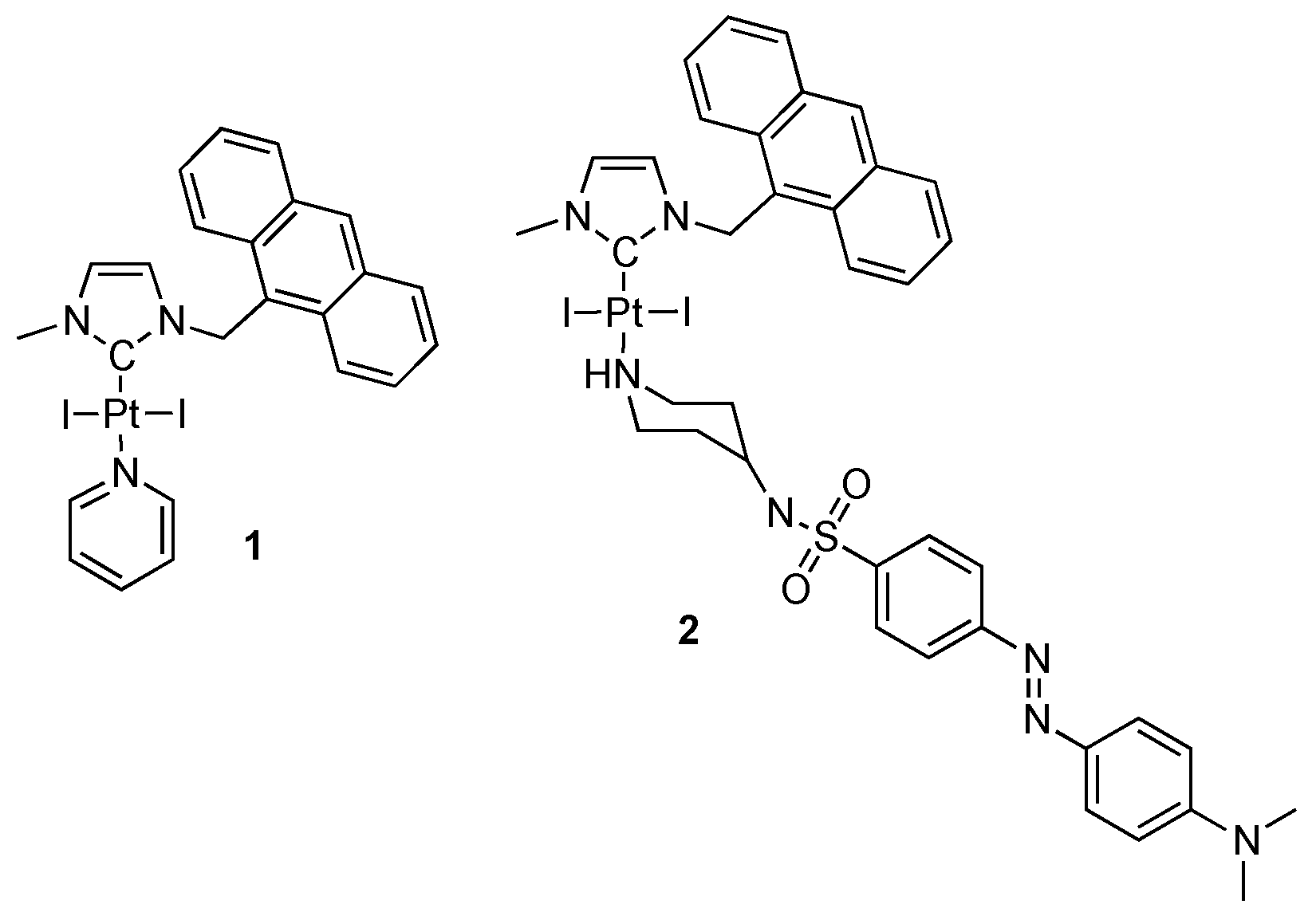
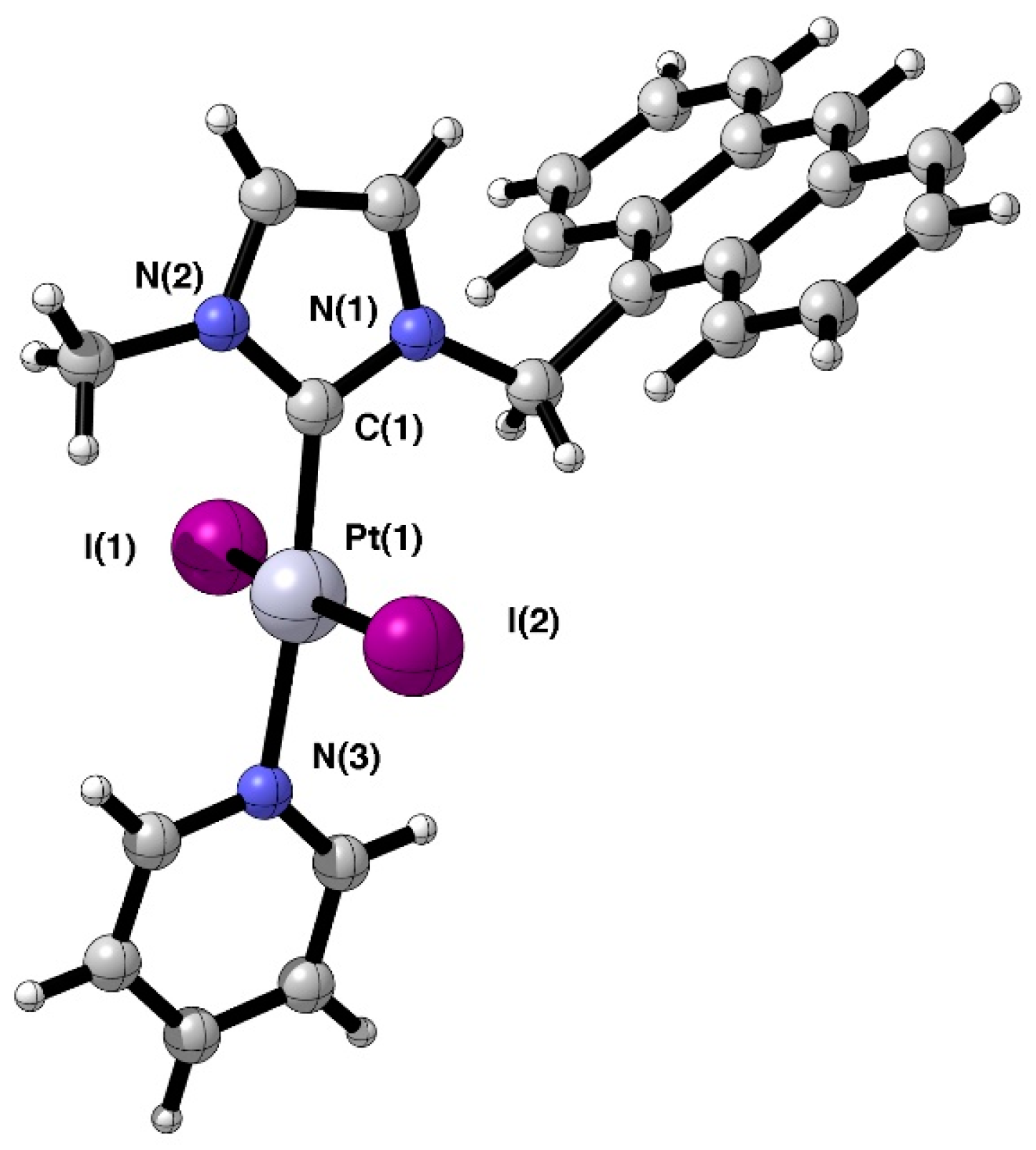
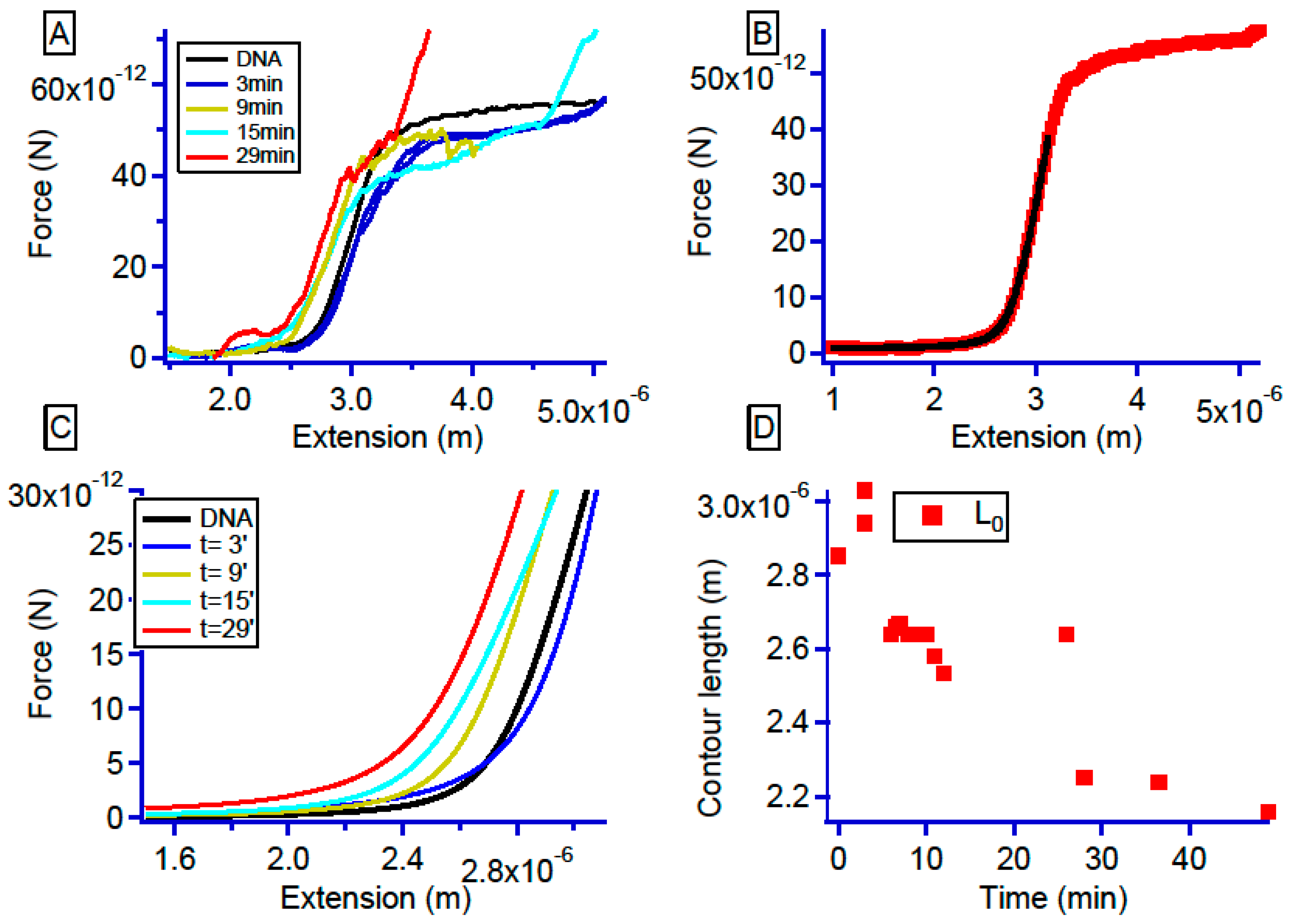
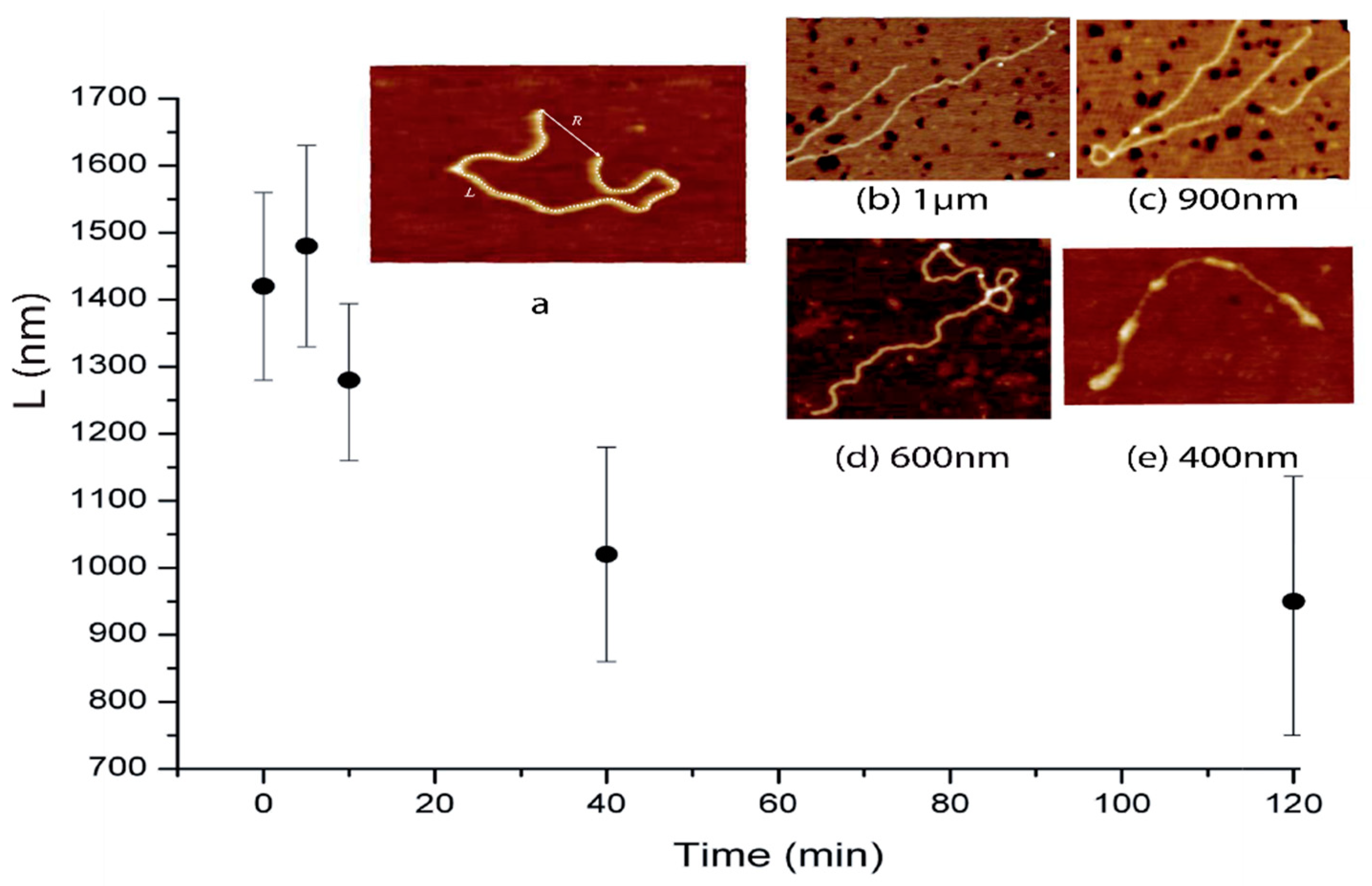
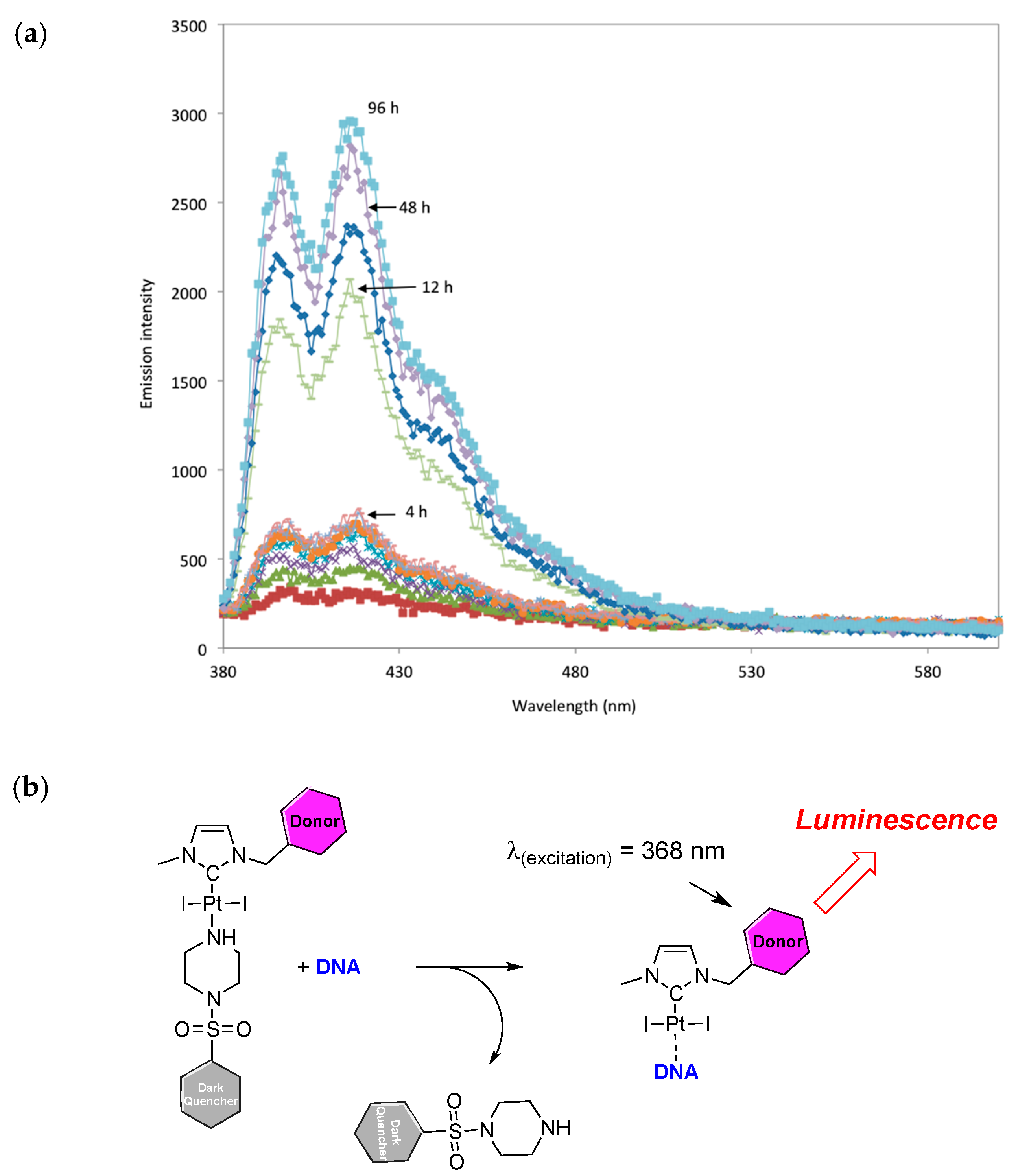

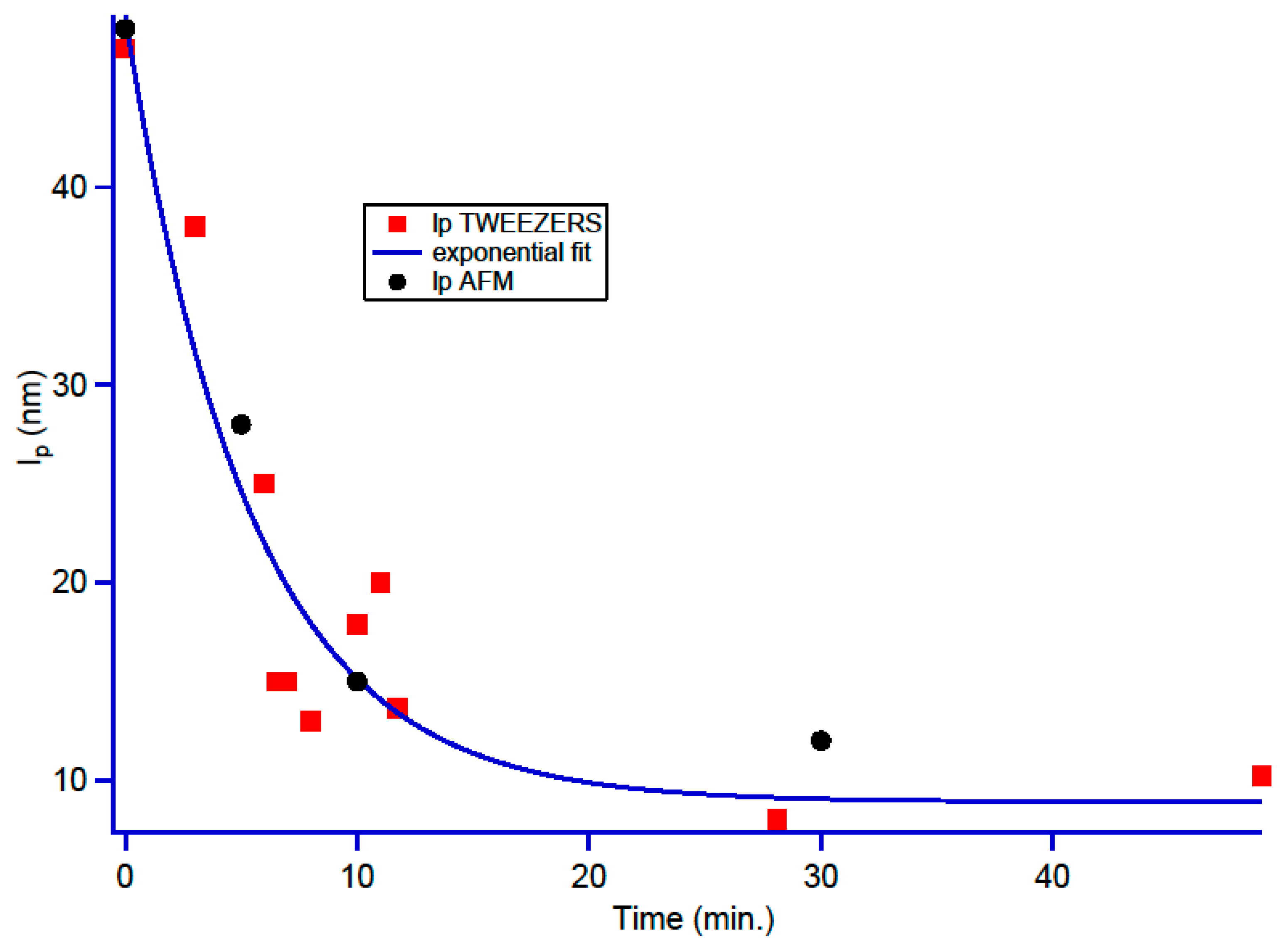
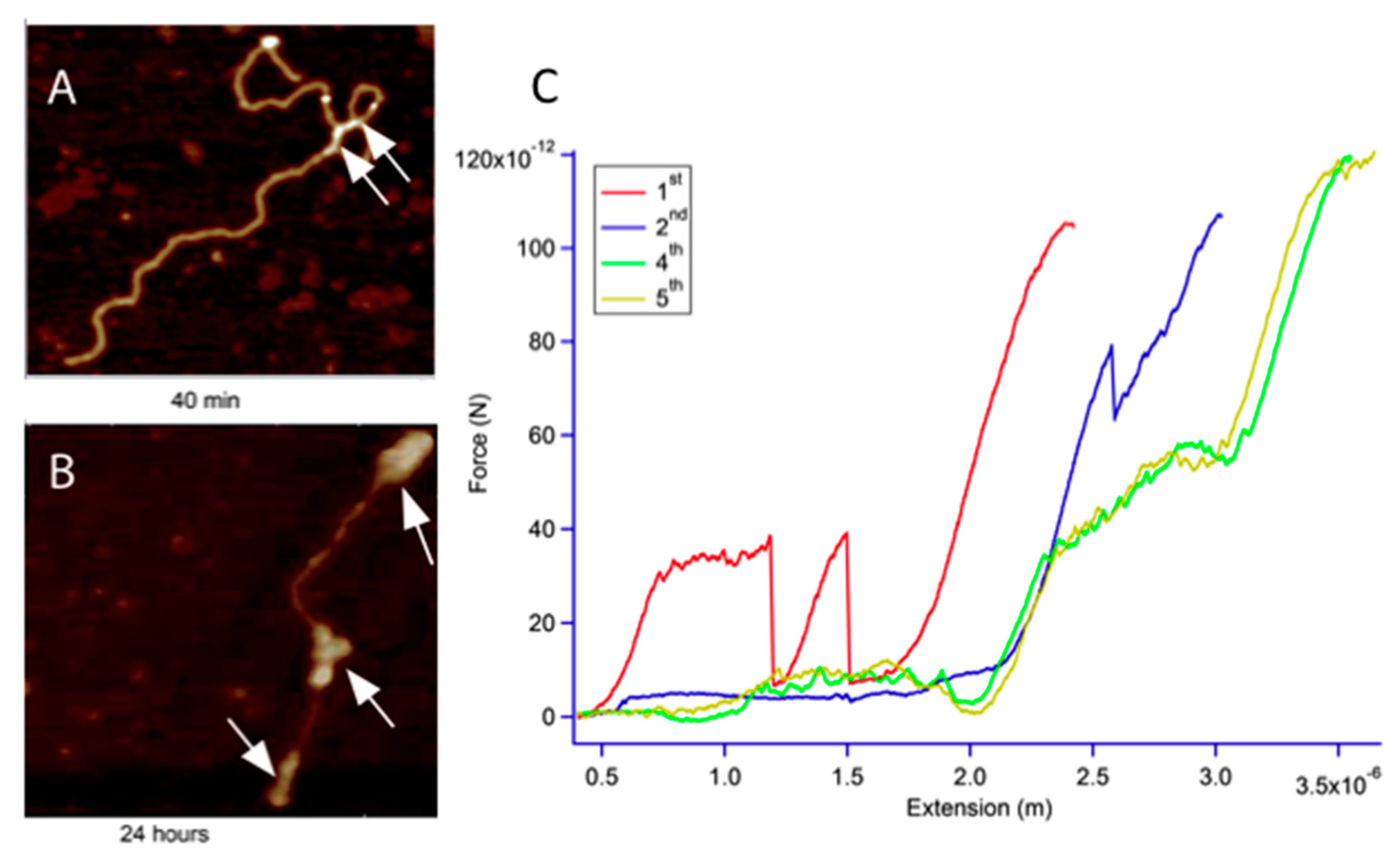
| Compound | MCF7 | HCT116 | PC3 | SK-OV3 | MRC-5 | EPC |
|---|---|---|---|---|---|---|
| 1 | 0.08 ± 0.01 | 0.01 ± 0.01 | 0.03 ± 0.01 | 0.02 ± 0.01 | 0.02 ± 0.01 | 0.08 ± 0.01 |
| Cisplatin | >10 | 3.3 ± 0.1 | 5.1 ± 0.4 | 4.4 ± 0.8 | 8.5 ± 0.1 | 2.2 ± 0.1 |
| Reactivity Ratio | >125 | 330 | 170 | 220 | 425 | 27.5 |
| Name | Value Literature | Reference |
|---|---|---|
| Kd = 8 µM | 0.35 < Kd < 26 µM | [61,62,63] |
| k1 = 0.025 M−1·min−1 | [60,64] | |
| k2 = 2 × 10−7 min−1 | Kd corresponds | |
| k3 = 0.055 M−1·min−1 | 57 < k < 8 ×10−3 M−1·min−1 | [65] |
| k4 = 5 × 10−9 min−1 | Adjusted from experiment | |
| Kd = 2.57 × 10−8 M | Kd = 10−8 M | [66,67] |
© 2019 by the authors. Licensee MDPI, Basel, Switzerland. This article is an open access article distributed under the terms and conditions of the Creative Commons Attribution (CC BY) license (http://creativecommons.org/licenses/by/4.0/).
Share and Cite
Harlepp, S.; Chardon, E.; Bouché, M.; Dahm, G.; Maaloum, M.; Bellemin-Laponnaz, S. N-Heterocyclic Carbene-Platinum Complexes Featuring an Anthracenyl Moiety: Anti-Cancer Activity and DNA Interaction. Int. J. Mol. Sci. 2019, 20, 4198. https://doi.org/10.3390/ijms20174198
Harlepp S, Chardon E, Bouché M, Dahm G, Maaloum M, Bellemin-Laponnaz S. N-Heterocyclic Carbene-Platinum Complexes Featuring an Anthracenyl Moiety: Anti-Cancer Activity and DNA Interaction. International Journal of Molecular Sciences. 2019; 20(17):4198. https://doi.org/10.3390/ijms20174198
Chicago/Turabian StyleHarlepp, Sébastien, Edith Chardon, Mathilde Bouché, Georges Dahm, Mounir Maaloum, and Stéphane Bellemin-Laponnaz. 2019. "N-Heterocyclic Carbene-Platinum Complexes Featuring an Anthracenyl Moiety: Anti-Cancer Activity and DNA Interaction" International Journal of Molecular Sciences 20, no. 17: 4198. https://doi.org/10.3390/ijms20174198
APA StyleHarlepp, S., Chardon, E., Bouché, M., Dahm, G., Maaloum, M., & Bellemin-Laponnaz, S. (2019). N-Heterocyclic Carbene-Platinum Complexes Featuring an Anthracenyl Moiety: Anti-Cancer Activity and DNA Interaction. International Journal of Molecular Sciences, 20(17), 4198. https://doi.org/10.3390/ijms20174198








